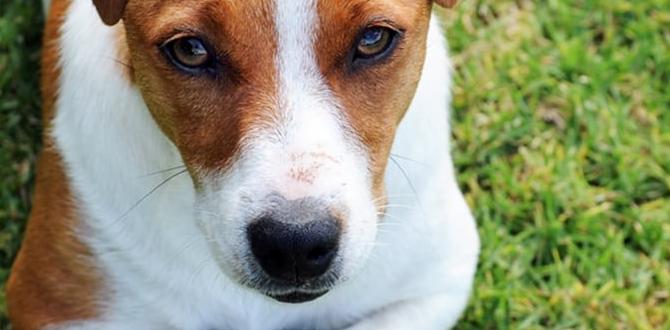Have you ever wondered why dogs love to play? Playing is more than just fun for them. It’s how they learn, communicate, and bond with others. Understanding dog play behavior step by step can help us connect better with our furry friends. Let’s explore the playful world of dogs together!
Key Takeaways
- Dog play helps build social skills and communication.
- Understanding dog play behavior step by step is important for bonding.
- Play can show a dog’s mood and energy level.
- Different dogs have unique play styles and preferences.
- Safe play is crucial for a happy and healthy dog.
Recognizing Dog Play Behavior Step by Step
Dog play behavior is fun and exciting to watch. It can look like a dance with jumps, runs, and barks. Dogs use play to show their feelings and to have fun with others. They start with a play bow, where the front legs stretch forward. This is an invitation to join the fun. Next, they may wag their tail, bark, or run in circles. Each step tells a story of joy and excitement. Understanding these steps can help us know when a dog is happy or when they want to play more gently.
- Play begins with a bow.
- Dogs may wag their tails rapidly.
- Running in circles is common.
- Barking can mean excitement.
- Jumping up shows high energy.
- Rolling over can mean trust.
Knowing these steps helps us engage better with dogs. We can join the play at the right moment and understand their needs. This understanding builds a strong bond between a dog and its owner. Each play session becomes a chance to learn more about each other. The more we know, the better we can care for our furry friends.
Fun Fact or Stats : Dogs can run up to 20 miles per hour during play!
How Dogs Invite Others to Play
Have you seen a dog bow its front legs with a wagging tail? This gesture is called a play bow. It’s a clear signal that a dog wants to play. This pose is like a friendly invitation. It’s how dogs say, “Let’s have some fun!” Dogs often use this gesture with other dogs and even humans. If you see a dog doing this, it might be time to grab a toy and join the fun!
Understanding Dog Body Language
Dogs use their bodies to communicate. A wagging tail, playful bark, and bouncing steps can tell us a lot. Do you know why a dog wags its tail? It can mean happiness and excitement. A playful bark is usually short and high-pitched. This tells others, “I’m having fun!” Watching a dog’s body language helps us understand their mood. It’s like learning a new language, step by step. Each movement has a meaning.
The Importance of Safe Play
Playing is fun, but it should also be safe. Dogs can get too excited and play rough. It’s important to set rules to keep them safe. Have you ever seen dogs nipping at each other? It might look scary, but it’s normal play. We should watch them closely during playtime. If things get too rough, it’s time for a break. Safe play ensures our dogs stay happy and healthy.
Different Types of Dog Play Behavior
Dogs love to play in many ways. Each dog has its own style. Some love to chase, while others enjoy tug-of-war. Understanding these different types helps us engage better with them. Chase is when one dog runs while another follows. It’s a game of speed and agility. Tug-of-war is a strength game. Here, dogs pull a toy in different directions. Fetch is a classic. It involves throwing a toy, and the dog retrieves it. Understanding these styles is key to happy playtime.
- Chase involves running after each other.
- Tug-of-war is a strength game.
- Fetch involves retrieving a thrown object.
- Hide-and-seek can be fun for smart dogs.
- Wrestling is playful, not aggressive.
Knowing these play styles helps us choose the right games. Each dog is unique, and finding their favorite game is important. This makes playtime fun and fulfilling for both dogs and their owners. It strengthens the bond and ensures a happy, healthy pet.
Fun Fact or Stats : Tug-of-war can improve a dog’s strength and coordination!
Benefits of Playing Chase
Chase is a favorite game for many dogs. Does your dog love to run? Chase allows them to stretch their legs and burn off energy. It’s also a great workout for their muscles. During chase, dogs practice their agility and speed. This game is often seen in parks where dogs have plenty of space. Playing chase with your dog can be a bonding experience. It’s a joy to see them run with such enthusiasm!
Why Dogs Love Tug-of-War
Tug-of-war is a special game for dogs. Have you tried it with your furry friend? It’s not just about pulling. It’s a game of strategy and strength. Dogs enjoy the challenge. This game helps build their muscles and keeps them mentally active. It’s important to let them win sometimes. This boosts their confidence and makes the game more rewarding.
Playing Fetch: A Timeless Classic
Fetch is probably the most popular dog game. Do you have a ball or a stick ready? Dogs love to chase after a thrown object and bring it back. This game is simple yet exciting for them. Fetch helps improve a dog’s focus and speed. It’s a great way to tire them out in a short time. Playing fetch regularly can keep your dog fit and happy.
Play Behavior Differences Between Breeds
Did you know different dog breeds play differently? Each breed has its own play style. Understanding these differences helps us meet their play needs. For example, retrievers love fetch, while herding breeds may enjoy chase games. Small breeds can be energetic and enjoy games indoors. Large breeds might prefer tug-of-war or fetch in wide spaces. Recognizing these differences ensures all dogs have fun playing.
- Retrievers enjoy fetch games.
- Herding breeds love chase games.
- Small breeds can play indoors.
- Large breeds need space for play.
- Terriers enjoy digging games.
Matching play to a dog’s breed ensures they stay happy and healthy. It provides mental stimulation and physical exercise. Each breed has unique energy levels and play requirements. Understanding these can make playtime more enjoyable for everyone.
Fun Fact or Stats : The Border Collie is known for its intelligence and love for play!
How Retrievers Play
Retrievers are known for their love of fetch. Do you own a retriever? Their energy and enthusiasm make them perfect for this game. They can retrieve objects from land or water. Fetch helps them stay active and sharp. Retrievers are friendly and enjoy playing with other dogs too. They love to run, making fetch the perfect game to satisfy their instincts.
Herding Breeds and Their Play Style
Herding breeds have a unique play style. Do you have a sheepdog or a collie? These dogs love to chase and herd. It’s in their nature. They enjoy games that involve running and guiding. This can include playing with a ball or a frisbee. They thrive in environments where they can use their speed and intelligence to outsmart others.
Small Breeds and Their Play Preferences
Small breeds have special play needs. Do you have a small dog at home? They might not need as much space to play. They can enjoy games like tug-of-war or hide-and-seek indoors. Small dogs can be very energetic and playful. It’s fun to watch them run around with their toys. Their small size allows them to play safely indoors.
Encouraging Healthy Dog Play
Healthy play is important for any dog. Do you encourage your dog to play daily? Active play keeps dogs fit and mentally sharp. It helps them burn energy and prevents boredom. When dogs play, they learn to socialize with others. This builds confidence and reduces anxiety. Encouraging play can be as simple as setting aside time each day. Find toys your dog loves and engage with them.
- Set daily playtime for your dog.
- Use toys that your dog likes.
- Ensure play is safe and supervised.
- Encourage social play with other dogs.
- Mix up the games to prevent boredom.
- Reward good play behavior.
Incorporating play into a dog’s daily routine benefits their health and well-being. It creates opportunities for bonding and ensures they lead a happy life. A playful dog is a joyful dog, and regular playtime can improve their quality of life.
Fun Fact or Stats : Dogs need about 30 minutes to 2 hours of play each day!
Setting Aside Daily Playtime
Setting aside time for play each day can make a big difference. Do you plan play sessions for your dog? Regular play helps keep them healthy and happy. If you’re busy, even a short session can be beneficial. Dogs need both mental and physical stimulation. Playtime is a great way to provide both. Regular play helps prevent unwanted behaviors caused by boredom.
Choosing the Right Toys
Choosing the right toys is key to fun play sessions. What toys does your dog love? From balls to plushies, the options are endless. Toys should match your dog’s size and play style. Safe toys ensure your dog won’t get hurt during play. Rotate toys to keep things fresh and interesting. This prevents boredom and maintains your dog’s interest in play.
Encouraging Social Play
Social play is important for dogs. Do you take your dog to meet others? Dogs are social animals. Playing with other dogs helps them learn social cues. It teaches them how to interact politely. Dog parks and play dates are great for this. Supervised play ensures safety and fun. Social play builds confidence and reduces fear of new situations.
Conclusion
Understanding dog play behavior step by step is key to happy pets. Play helps dogs learn, bond, and stay active. By recognizing their play styles, we can engage with them better. Different breeds have unique play needs. Encouraging healthy play leads to happy, well-adjusted dogs. Let’s make playtime a priority for our furry friends!
FAQs
Question: What is a play bow in dogs?
Answer: A play bow is when a dog lowers its front legs and keeps its rear up. It’s an invitation to play, showing the dog is friendly and ready for fun. Understanding this step in dog play behavior helps us know when they’re eager to engage.
Question: How can I tell if my dog is playing or fighting?
Answer: Watch their body language. Playing dogs have relaxed bodies, wagging tails, and may bow. They switch roles during play, while fighting dogs seem tense. Understanding dog play behavior step by step helps distinguish play from aggression.
Question: How much play does my dog need daily?
Answer: Dogs need between 30 minutes to 2 hours of play each day. It depends on their breed, age, and energy level. Regular play ensures they stay happy and healthy, helping burn energy and avoiding boredom.
Question: Can playing help reduce my dog’s anxiety?
Answer: Yes, play can reduce anxiety in dogs. It provides exercise and mental stimulation, which helps them relax. Understanding dog play behavior step by step also builds confidence, reducing stress and anxiety over time.
Question: Are some dog breeds more playful than others?
Answer: Yes, different breeds have different play levels. Retrievers and terriers are known for their playful nature. Understanding each breed’s play style can help tailor activities to keep them engaged and happy.
Question: How can I safely introduce my dog to other dogs?
Answer: Begin in a neutral, safe space. Observe their body language carefully. Let them sniff and greet each other calmly. Use positive reinforcement, and supervise play closely. Understanding dog play behavior step by step ensures a safe and enjoyable interaction.
Meet Elyse Colburn, the devoted canine companion and storyteller behind the enchanting world of “Tales, Tails, and Adventures Unleashed.” A passionate dog enthusiast with a heart full of paw prints, Elyse Colburn shares heartwarming tales and insightful adventures, celebrating the joy, loyalty, and endless antics that make every dog a true hero. Join Elyse Colburn on this tail-wagging journey, where every post is a love letter to our four-legged friends.








